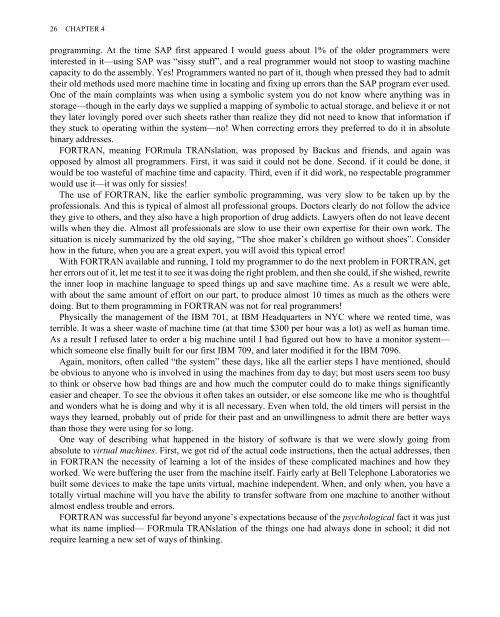hamming
hamming
hamming
You also want an ePaper? Increase the reach of your titles
YUMPU automatically turns print PDFs into web optimized ePapers that Google loves.
26 CHAPTER 4programming. At the time SAP first appeared I would guess about 1% of the older programmers wereinterested in it—using SAP was “sissy stuff”, and a real programmer would not stoop to wasting machinecapacity to do the assembly. Yes! Programmers wanted no part of it, though when pressed they had to admittheir old methods used more machine time in locating and fixing up errors than the SAP program ever used.One of the main complaints was when using a symbolic system you do not know where anything was instorage—though in the early days we supplied a mapping of symbolic to actual storage, and believe it or notthey later lovingly pored over such sheets rather than realize they did not need to know that information ifthey stuck to operating within the system—no! When correcting errors they preferred to do it in absolutebinary addresses.FORTRAN, meaning FORmula TRANslation, was proposed by Backus and friends, and again wasopposed by almost all programmers. First, it was said it could not be done. Second. if it could be done, itwould be too wasteful of machine time and capacity. Third, even if it did work, no respectable programmerwould use it—it was only for sissies!The use of FORTRAN, like the earlier symbolic programming, was very slow to be taken up by theprofessionals. And this is typical of almost all professional groups. Doctors clearly do not follow the advicethey give to others, and they also have a high proportion of drug addicts. Lawyers often do not leave decentwills when they die. Almost all professionals are slow to use their own expertise for their own work. Thesituation is nicely summarized by the old saying, “The shoe maker’s children go without shoes”. Considerhow in the future, when you are a great expert, you will avoid this typical error!With FORTRAN available and running, I told my programmer to do the next problem in FORTRAN, gether errors out of it, let me test it to see it was doing the right problem, and then she could, if she wished, rewritethe inner loop in machine language to speed things up and save machine time. As a result we were able,with about the same amount of effort on our part, to produce almost 10 times as much as the others weredoing. But to them programming in FORTRAN was not for real programmers!Physically the management of the IBM 701, at IBM Headquarters in NYC where we rented time, wasterrible. It was a sheer waste of machine time (at that time $300 per hour was a lot) as well as human time.As a result I refused later to order a big machine until I had figured out how to have a monitor system—which someone else finally built for our first IBM 709, and later modified it for the IBM 7096.Again, monitors, often called “the system” these days, like all the earlier steps I have mentioned, shouldbe obvious to anyone who is involved in using the machines from day to day; but most users seem too busyto think or observe how bad things are and how much the computer could do to make things significantlyeasier and cheaper. To see the obvious it often takes an outsider, or else someone like me who is thoughtfuland wonders what he is doing and why it is all necessary. Even when told, the old timers will persist in theways they learned, probably out of pride for their past and an unwillingness to admit there are better waysthan those they were using for so long.One way of describing what happened in the history of software is that we were slowly going fromabsolute to virtual machines. First, we got rid of the actual code instructions, then the actual addresses, thenin FORTRAN the necessity of learning a lot of the insides of these complicated machines and how theyworked. We were buffering the user from the machine itself. Fairly early at Bell Telephone Laboratories webuilt some devices to make the tape units virtual, machine independent. When, and only when, you have atotally virtual machine will you have the ability to transfer software from one machine to another withoutalmost endless trouble and errors.FORTRAN was successful far beyond anyone’s expectations because of the psychological fact it was justwhat its name implied— FORmula TRANslation of the things one had always done in school; it did notrequire learning a new set of ways of thinking.


